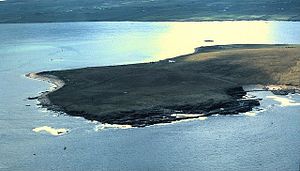Eynhallow
| Eynhallow | |
|---|---|
| Aerial view | |
| Waters | North Sea |
| Archipelago | Orkney Islands |
| Geographical location | 59 ° 9 ′ 0 ″ N , 3 ° 7 ′ 0 ″ W |
| length | 1.4 km |
| width | 1.3 km |
| surface | 75 ha |
| Highest elevation | 40 m |
| Residents | uninhabited |
Eynhallow , the "Holy Island" from Old Norse Eyin Helga, is an uninhabited, 75 ha large island of Orkney in the same sound ( Sound ) between Mainland and Rousay . It reaches a height of 40 meters.
When the island was evacuated in 1851 on the occasion of an epidemic and wanted to make the buildings uninhabitable, it was surprisingly discovered that one of the houses was originally a church.
Eynhallow Church is located on the south side and is a building from the 12th century, which was used as a church until the 16th century, then as a residential and farm building. It is probably the successor to an older monastery to which the Orkneyinga saga (in Chapter 97) refers. The well-known British architectural theorist and architect William Lethaby , who visited the as yet unserved ruin in 1897 and described the structural condition in detail, interpreted the entire complex as a monastery - a position that is no longer held today. Rather, the remaining building remains and courtyard walls are interpreted as remnants of subsequent use as farm and residential buildings.
There are 25 other registered ground monuments on the island, including the foundations of two possible round houses at Little Kyarl and Munkerness . The Cairns present on the island (NMRS Number: HY32NE 14 (The Grand) and HY32NE 30) are addressed today as being medieval at the earliest. So they are not of prehistoric, but more recent origin as a result of the agricultural use of the island.
The former importance of the island is underlined by numerous legends. The farmers of the neighboring islands bring earth from the island to protect their grain from vermin. A stone from Eynhollow was built into the entrance to the house.
Eynhallow is home to one of the largest fulmar colonies in the British Isles .
Individual evidence
- ^ Official topographic map
- ^ Royal Commission on the Ancient and Historical Monuments of Scotland writes: clearance heap probably contemporary with the rig and furrow cultivation around it .

